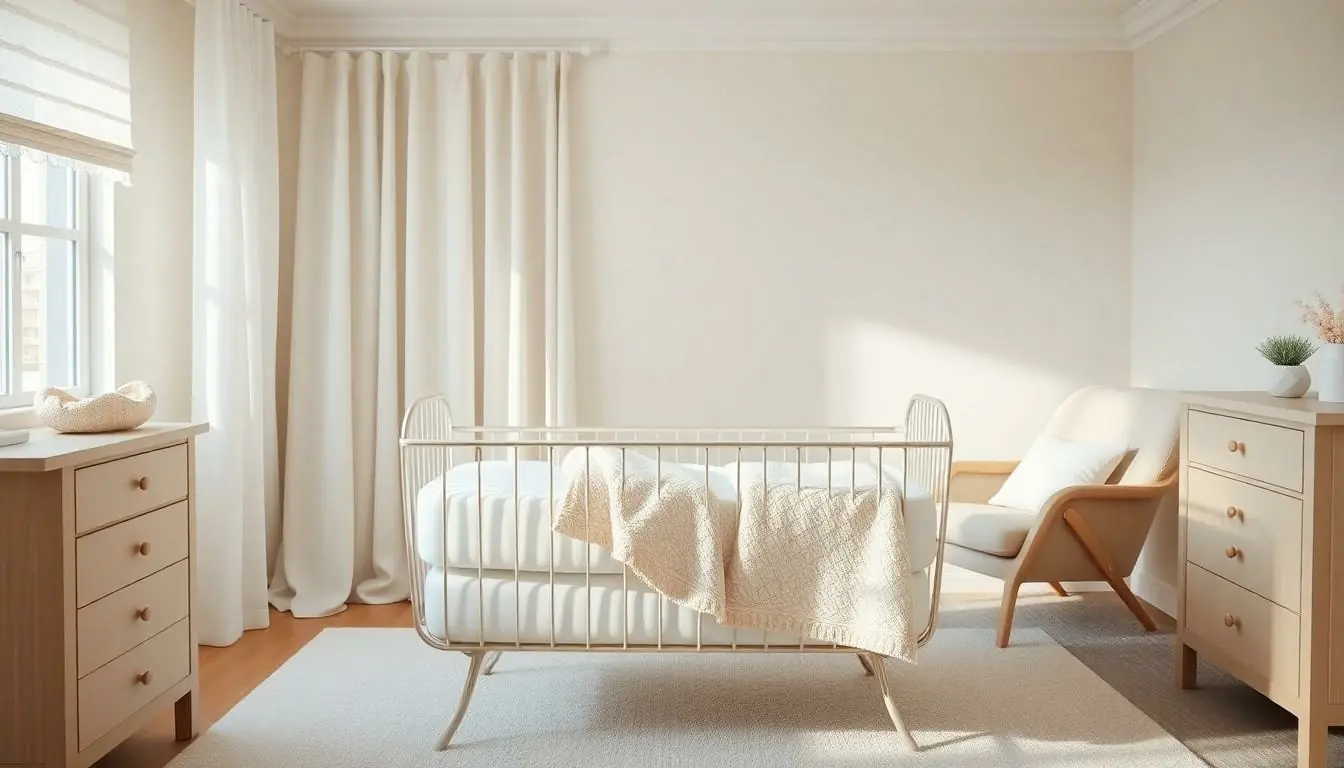Getting a newborn to sleep in a bassinet can feel like trying to convince a cat to take a bath—challenging and often comical. New parents might find themselves in a battle of wills, armed with swaddles and lullabies, while their little one protests like a tiny rock star refusing to go on stage. But fear not! There are proven tips that can turn those sleepless nights into peaceful slumbers.
Table of Contents
ToggleUnderstanding Newborn Sleep Patterns
Newborns operate on unique sleep patterns that differ significantly from adult sleep cycles. Typically, a newborn sleeps about 14 to 17 hours per day but only in short stretches of 1 to 3 hours. Establishing an understanding of these cycles is crucial for parents aiming to help their infants adapt to sleeping in a bassinet.
Awareness of a newborn’s sleep stages enhances the ability to create a conducive sleep environment. Each sleep cycle consists of both active and quiet sleep phases. During active sleep, the baby may move, grunt, or startle, while quiet sleep allows for more restful periods. Parents can observe these changes to synchronize bedtime routines.
Recognizing the importance of the wake-window duration is vital. A newborn typically stays awake for about 45 to 60 minutes between sleep spells. After this time, signs of tiredness may manifest, including yawning, fussiness, or rubbing eyes. Capturing these cues helps establish a timely bedtime routine.
Infants also respond positively to a consistent sleep environment. Dim lighting and a quiet atmosphere signal bedtime. Additionally, swaddling provides comfort and security, mimicking the womb’s sensation. Parents can enhance this effect by using gentle lullabies or white noise, which may soothe a restless baby.
Ultimately, understanding these key factors aids in creating an optimal sleep strategy for newborns. Adjusting to their natural cycles, recognizing tired signs, and providing a soothing sleep environment all contribute to better sleep in the bassinet. Each small adjustment can result in more peaceful nights for both parents and their little ones.
Creating a Comfortable Sleeping Environment

Creating a soothing sleep space significantly influences a newborn’s comfort and ability to sleep in a bassinet.
Choosing the Right Bassinet
Selecting a bassinet involves considering safety, size, and comfort. Choose one that meets safety standards, offering a sturdy base and breathable materials. That means avoiding soft bedding and toys inside to minimize suffocation risks. Consider a size that easily fits in the intended space while allowing your baby to stretch comfortably. Opt for a bassinet with a flat, firm mattress, ensuring your newborn feels secure. Look for adjustable features too; some models allow modifications to suit your baby’s growth and needs better.
Setting the Ideal Room Temperature
Maintaining the right room temperature helps create a conducive sleep environment. Keeping the nursery between 68 to 72 degrees Fahrenheit generally suits newborns. Use a reliable thermometer to check the temperature consistently. Layer your baby’s clothing appropriately, avoiding overheating by choosing light, breathable fabrics. Monitor for signs of discomfort; if your baby feels sweaty or cold, adjust accordingly. Ensure good ventilation in the room, facilitating a fresh atmosphere without drafts.
Establishing a Bedtime Routine
Creating a bedtime routine significantly impacts a newborn’s ability to sleep in a bassinet. Establishing such a routine fosters a sense of security, helping the baby understand when it’s time to sleep.
Importance of Consistency
Consistency plays a vital role in a newborn’s sleep. Babies thrive on predictable patterns, which help regulate their internal clocks. Setting a specific bedtime reinforces this pattern, signaling to the newborn that it’s time to wind down. Sticking to this routine nightly strengthens the association between activities and sleep. Parents noticing better sleep quality often cite regularity as a key factor. Maintaining this consistent schedule not only aids in sleep but also benefits the whole family.
Activities to Incorporate Before Sleep
Incorporating certain activities before sleep can ease the transition into slumber. Parents can consider bathing their baby to promote relaxation. Reading a short, soothing story or singing a lullaby often helps calm infants. Gentle rocking or swaddling prepares the baby for comfort. Dim lighting in the room can signal to the newborn that nighttime has arrived. Creating a serene atmosphere enhances the effectiveness of these activities. By engaging in these practices, parents set the stage for peaceful nights in the bassinet.
Techniques to Help Your Newborn Sleep
Implementing effective techniques is key to ensuring a newborn sleeps comfortably in a bassinet.
Swaddling for Comfort
Swaddling provides a sense of security for newborns, mimicking the snug environment of the womb. This technique helps to limit startle reflexes, promoting longer sleep stretches. Choose breathable fabrics to avoid overheating, and wrap the baby snugly but not too tightly around the arms and legs. Monitoring for signs of discomfort is important. Adjust the swaddle based on the baby’s response; for some, being tightly wrapped is soothing, while others prefer more freedom. Swaddling can be especially effective during the first few months, as babies gradually adapt to their new sleeping environment.
White Noise and Soothing Sounds
White noise machines discourage unwanted background noise and create a constant auditory backdrop that calms newborns. Playing sounds reminiscent of the womb, such as heartbeat rhythms, can enhance relaxation. Soft lullabies or nature sounds also promote sleep by masking disturbances in the environment. Volume levels must remain safe; keeping them at about 50 decibels is recommended. Gradually introducing these sounds during the bedtime routine establishes a habit. Consistent use of white noise or soothing sounds can lead to improved sleep patterns and reduce fussiness.
Monitoring Safety in the Bassinet
Monitoring safety during bassinet sleep is essential for newborns. Parents need to ensure that the bassinet adheres to safety guidelines, such as meeting the Consumer Product Safety Commission standards. Maintaining a clear sleep space is crucial. Soft objects, including blankets, pillows, and toys, should never be placed in the bassinet, as these pose suffocation risks.
Checking the mattress firmness is vital. A firm mattress allows for safer sleep by reducing the chances of the baby sinking or rolling. Regularly inspecting the bassinet for any loose or damaged parts ensures a secure environment. If the bassinet shows signs of wear, it’s time to look for safer options.
Room temperature plays an essential role in the baby’s comfort. Keeping the nursery ventilated and maintaining a temperature between 68 and 72 degrees Fahrenheit helps prevent overheating. Dressing the baby in light layers contributes to consistent comfort, ensuring safety throughout the night.
Reassessing the baby’s position in the bassinet is necessary. Babies should always be placed on their backs for sleep, which significantly lowers the risk of Sudden Infant Death Syndrome. Safety practices resonate with all aspects of sleep, from choosing the right wear to maintaining a secure sleeping environment.
Parents and caregivers should remain attentive. Frequent checks on the sleeping baby not only promotes safety but also fosters reassurance. Sound monitors can be beneficial for parents wishing to keep a watchful eye while attending to other tasks.
Getting a newborn to sleep in a bassinet can be a challenging journey for new parents. By understanding sleep patterns and establishing a consistent bedtime routine, parents can create a nurturing environment that promotes restful sleep. Incorporating techniques like swaddling and white noise can further enhance comfort and security.
Safety remains a top priority, so ensuring the bassinet meets guidelines is essential. With patience and persistence, parents can transform their baby’s sleep experience. Embracing these strategies not only benefits the newborn but also leads to more peaceful nights for the entire family. A little effort goes a long way in fostering healthy sleep habits for the newest member of the family.



